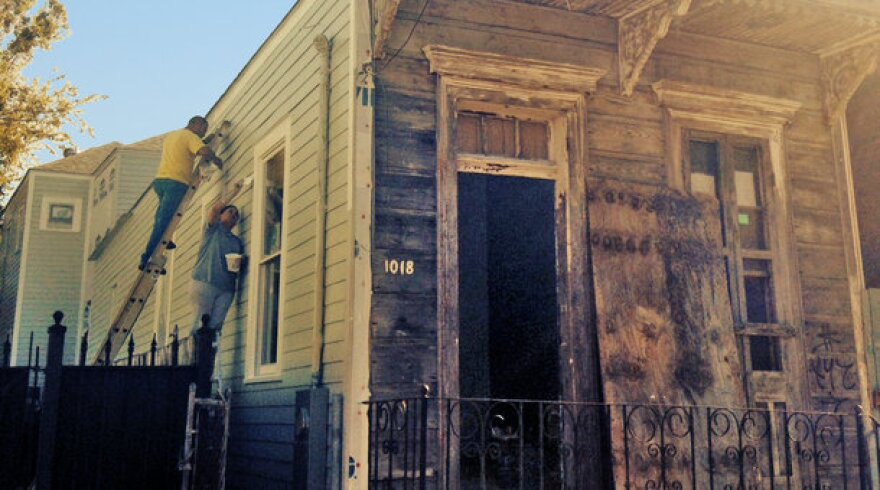About a year ago, Greg Thyssen and Shakti Belway bought an 1800's double shotgun in the Tremé neighborhood.
"I'm tall," Thyssen said, "so I love the high ceilings, a fireplace in every room, beautiful pocket doors."
Beauty, yes, but the house needed work. "The floors were eaten away by termites," Belway said, "and under layers and layers of linoleum."
But the couple, both with post-graduate degrees, knew they wanted to live in Tremé. It's so... New Orleans, this historically African-American neighborhood, just across Rampart Street from the French Quarter. Shakti, a California native, is eight months' pregnant, and can see bringing up her child here. "We think about that every day," she said.
One thing they worry about, though, is more people like them moving in.
"I recognize that, on one hand, I am gentrification," Thyssen said, "but on the other hand, I'm against gentrification because I don't want this neighborhood to lose its magic."
That magic comes from Second Lines, for one. The traditional Sunday street parades often wind through Tremé. At end of one parade, Patricia MacDonald was selling gumbo.
"It has shrimps and hot sausage, chicken necks and chicken gizzards," she said.
MacDonald has lived in Tremé for 34 years, but recently had to move when the place she rented went up for sale. She felt lucky to find an apartment she could afford a few blocks away. She said many new owners convert historic doubles into single-family houses. That means fewer rental units. And the pricetags send a message.
"You trying to run us out of New Orleans," she said. "Out of here. You know we can't afford $287,000."
That's what a nearby house recently sold for. High dollar for what Tremé is used to, but cheap for people coming from Los Angeles or New York. And increasingly, real estate agent Eric Wilkinson said, people are.
"This is by far the most active the market's ever been, in at least the last decade," he said. "The most people moving to New Orleans, buying in New Orleans."
He says New Orleans has joined the "it" list, with cities like San Francisco and Austin, but cheaper. And those with fresh eyes have an advantage over natives.
"I mean, when you call a street Rampart, which literally means barrier, and people grow up thinking 'don't go across Rampart Street,'" he said. "Whereas people from out of town don't have those preconceived notions. It makes it easier for them to take the leap of faith."
Not to mention most newcomers have no personal memory of the floods after Hurricane Katrina. Which, interestingly, is part of why they're coming, even if they don't know it. A hundred-plus billion dollars of federal aid rebuilt the flood protection system and roads. With those in place, big projects like hospitals broke ground. That's bred investor confidence, for things like restaurants and retail.
Take the historic St. Roch Market, on St. Roch Avenue, in a neighborhood called St. Roch. It sat empty for decades.
"A year ago it was boarded up, covered in graffiti," said Sarah Chase, a St. Roch resident and New Orleans editor of Curbed, a national real-estate blog. "The bones of the building were still there, you could tell it was something amazing, but it wasn't very nice to look at."
Now, after a $3.7 million renovation, the market building stands up straight, pure white inside. But this special space is luring special tenants, like fancy cheese and meat sellers. Some locals are nervous.
"They don't want a gourmet market moving into their neighborhood, or they don't want something they can't afford," Chase said. "At the same time, we live in a food desert."
The chain supermarket down the street didn't re-open after Katrina. And so there is an uneven patchwork: a beautifully restored Victorian next door to a boarded-up mess. A place to buy a free range chicken, but no regular grocery.
The business and residential boom is mostly unfolding on urban, higher ground -- areas that had blight before Katrina, but did not flood badly. The more suburban, deluged fringes of New Orleans now lag behind. That's where the working poor get pushed, as historic areas gentrify.
Belway, the Tremé homeowner, holds out hope for a middle ground.
"The very things that make this city special could be lost," she said. "But it doesn't have to happen that way."
With the right policies and programs, she said, New Orleans can help longtime residents stay in their homes. That way the city's oldest, most storied neighborhoods will hold onto not just their beautiful buildings, but a more delicate, precious asset: their culture.



